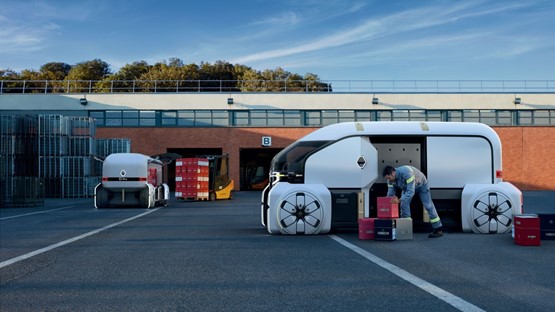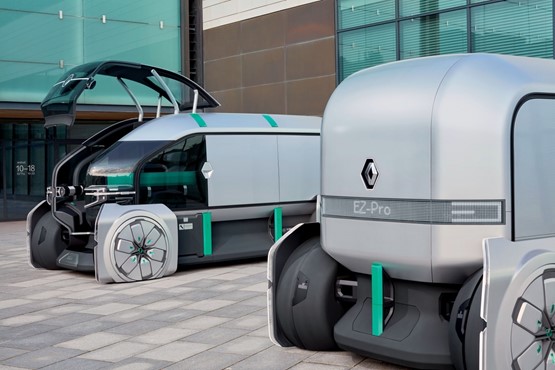
A ‘last mile’ autonomous delivery van concept conceived in partnership with global logistics firm DPD has been unveiled by Renault.
Designed for city centre use, the Ez-Pro consists of a manned pod linked virtually to up to four cargo-carrying platforms.
While manned, the lead ‘command’ pod would be occupied by a concierge rather than a driver, the manufacturer says of its vision of an inner-city LCV in 2030, unveiled at the Hannover Motor Show in September.

Each of the ‘robo-pods’ would have a range of 300 kilometres (186 miles) on a single charge.
In a city environment, Renault believes this would enable the Ez-Pro to be used almost continuously between battery charges.
Utilisation could be further enhanced by the battery being topped up on dynamic inductive charging – the EV being charged wirelessly via technology built into the road’s surface, whether stationary or on the move.
Driven autonomously, the pods could each split off from the linked ‘road train’ for separate destinations where they would deliver or pick up goods – or be used as retail outlets or parcel collection points.
The Ez-Pro would reduce congestion by limiting delivery journeys.
Pods are designed for specific requirements – from goods storage to a stall or coffee shop that would be lifted on and off the wheeled platform at transport hubs supplied by trucks on the outskirts of cities in a similar way to the movement of shipping containers today.
“A convoy of pods leaving from the same hub and managed by the same logistics operator can carry different types of goods and merchandise, each pod having its own paymaster, theme, clientele and delivery place,” Renault says.
“They are, however, operated by the same electric and autonomous platform. In the same manner, a pod can make a series of deliveries for one online store and another series for a different store.
"These shared scenarios contribute to maximise productivity and save costs.”

The concierge would be needed to provide the essential ‘human touch’ when handing over items to customers, Renault believes.
The lead pod, while equipped with a control joystick and four-wheel steering, would really be a workspace for the employee.
They would do whatever was required for them to be working most efficiently and to provide the best customer service.
DPD, which delivers 4.8 million parcels a day worldwide, worked with Renault on Ez-Pro to identify realistic scenarios for its use and will continue to influence the design and use of the electrically-powered, autonomous and connected LCV.
“Together we are sharing our vision of future goods and service transport requirements, ensuring they are relevant to our customers,” says Philippe Diviné, Renault’s LCV strategy director.
A pod equipped with storage lockers was part of the vehicle’s reveal as an example of how DPD could provide a collection solution for its parcel customers.
The battery range was specified by DPD as representing realistic urban use.
It also helped influence the size and cargo capacity of the pods, the self-parking function that would allow the concierge to leave their pod and not spend time looking for a space and the ability to summon the Ez-Pro via a mobile app.
Cargo volume for the Ez-Pro is six cubic metres for the lead pod, up to one tonne, or 12m3 (two tonnes) for the ‘robo-pod’.
Diviné is pragmatic about the likelihood of its vision becoming reality.
“This is our vision today of what an electrically-powered, connected and autonomous van could look like in 2030 based on the technology and the understanding of urban transport needs and environmental considerations we are facing now,” he says.
“This vision can change as the technology develops and or needs change. Like any concept we want feedback on it from customers such as DPD.”

The Ez-Pro is the second vehicle revealed by Renault this year as it builds on its six-year goal for ‘sustainable mobility for all’ outlined in its Drive the Future plan launched in 2017.
Alongside financial objectives of revenues exceeding €70 billion (£62.4bn) and an operating margin of more than 7%, it expects to increase vehicle sales by more than 40% to in excess of five million units, compared to 3.5m in 2016.
It will lead the way in operating the most electric vehicles in its range: eight pure electric and 12 hybrids.
Ez-Pro was preceded by the unveiling of Ez-Go at the Geneva Motor Show in March (www.fleetnews.co.uk/ez-go-geneva).
A ‘robot-vehicle’, the electric car could take up to six passengers and, with no steering wheel or driver, move autonomously at a maximum 30mph.
Third EZ model launched
The third and final of Renault’s trilogy of current concept cars was dubbed a robo-vehicle by the manufacturer at its unveiling at the 2018 Paris Motor Show.
The EZ-Ultimo is a premium ride-hailing car, ‘a mobile lounge’ incorporating wood, marble and leather, for use in ride-hailing on-demand, for between an hour and a day.
Alongside the Zoe and Twizy in its electric car range, Renault offers an electric Kangoo and will soon be marketing the Master ZE (zero emission) to give what it claims is the most comprehensive electric LCV line-up in the UK.
Meanwhile truck manufacturers are also playing their part. Volvo-owned Renault Trucks will introduce a range of fully electric trucks in 2019 after 10 years of testing vehicles designed for “urban and inner city situations”. (www.commercialfleet.org/renaultelectrictruck).
These would bring goods to hubs surrounding major urban centres, where the container pods would be unloaded onto the wheeled platforms.
Laurens van den Acker, senior vice president, Renault corporate design, says: “With Ez-Pro, we continue our exploratory work around future urban shared mobility.
“Focused on delivery solutions, this autonomous, connected and electric concept represents the ideal tool, being both a creator of opportunity for professionals and a facilitator of services for all its users, direct or indirect.
“It is based on Renault’s expertise in commercial vehicles and on the brand’s DNA, which places people at the heart of its solutions.”
EZ-Pro is not seen by Renault as the solution for the long-term
Renault admits the Ez-Pro is not an entirely realistic vision of a future LCV, but insists that while it plans to meet transportation needs more than 10 years from now, its planning is as much focused on fleets’ needs in the short-term as it is those in 2030.
Philippe Divine (pictured) , Renault’s LCV strategy director, outlined the factors supporting the manufacturer’s current plans to Commercial Fleet.

Commercial Fleet: 2030 is so far away as to be irrelevant to the issues facing LCV operators now or in the next five years. Why should the Ez-Pro be of relevance to fleet decision-makers more concerned about the short-term?
Philippe Divine: Our vehicles will continue to evolve as you would expect following visual trends and practical requirements.
But there are four major factors disrupting current trends: electrification to meet city emission requirements, connectivity, user-orientated services and functionality and autonomy towards driverless vehicles.
You will see technologies supporting these emerging in our vehicles sooner or later. Ez-Pro in an interpretation of the technologies we see impacting on logistics in 2030. It’s the start of the journey – not the complete answer.
CF: Will you see a short-term shift in your revenue model away from vehicle purchase or long-term lease towards non-ownership, pay per use?
PD: It is an option and I wouldn’t discard it. But speaking specifically about commercial vehicles, schemes of this type are already in place. For example, there are operators moving refrigerated goods already running the required vehicles on a pay per use basis.
It’s easy to find people who don’t lease, but rent vehicles during peak periods of demand.
CF: Are you looking at increasing the utilisation of a vehicle to ensure they are being used 80-100% of the working day?
PD: Such a goal has informed the thinking of the battery range of the Ez-Pro.
Today, many companies tell us a big part of their fleet dedicated to parcel delivery and of a comparable size to the Ez-Pro are expected to be used from morning until evening in a single shift without returning to the hub to reload or recharge.
CF: What’s the future of service, maintenance repair schedules and costs on LCVs with Ez-Pro technology in mind?
PD: The drivetrain is more efficient to maintain in an electric vehicle rather than a conventional petrol or diesel engine. For example, you don’t need to change the oil.
At some point, if we manage to get autonomous vehicles on the road, it will be because there is a clear advance in terms of safety – so less braking means less brake wear and tear and lower maintenance and repair costs.
However, the opposite is also true. Autonomous, connected electric vehicles will be more complex. Technology upgrades will be more frequent and significant, from software to hardware, from fitting a more advanced battery to a computer with greater processing power.
The SMR activity could change, but I can’t tell you the impact on downtime and cost. The skillset of those carrying out the work will have to change, no doubt.
CF: How much will customers pay for the Ez-Pro?
PD: The only answer I give is customers, like DPD, will be willing to pay for it because globally it’s cheaper than paying for a driver and a conventional vehicle.
CF: How long has diesel got a part to play in the Renault range?
PD: We see the opposition to diesel, but I can’t give you an answer.
Our plan to increase electrification of the range started more than 10 years ago and we’re only going to continue to further its importance and increase the choice of electric vehicles.






















Login to comment
Comments
No comments have been made yet.